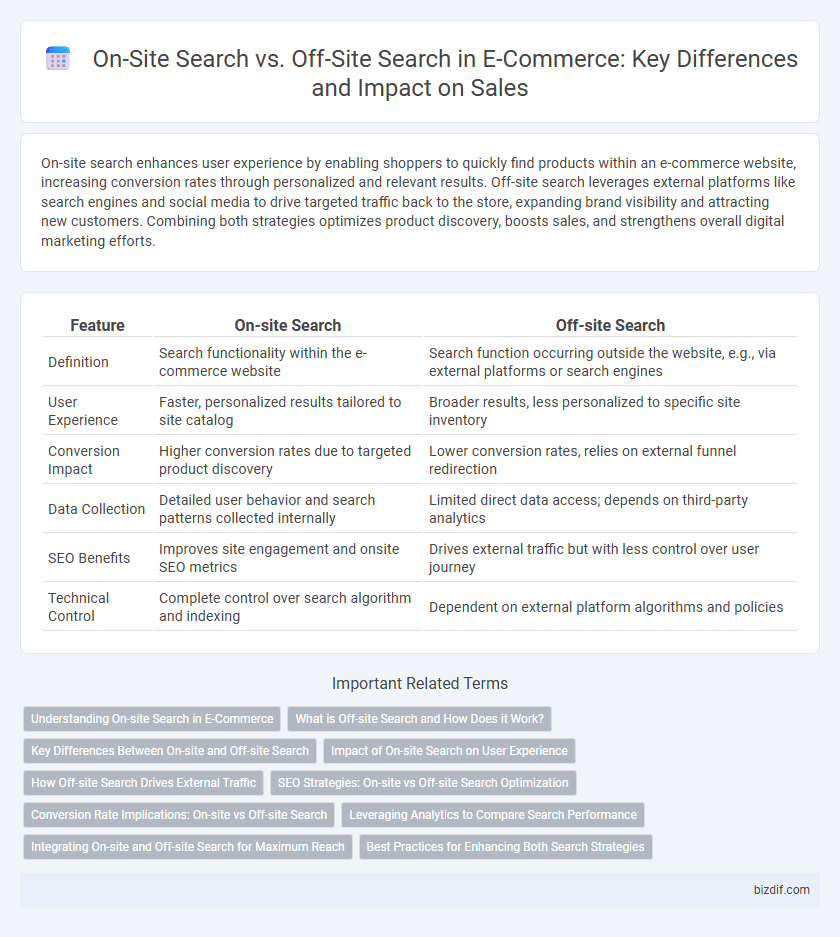On-site search enhances user experience by enabling shoppers to quickly find products within an e-commerce website, increasing conversion rates through personalized and relevant results. Off-site search leverages external platforms like search engines and social media to drive targeted traffic back to the store, expanding brand visibility and attracting new customers. Combining both strategies optimizes product discovery, boosts sales, and strengthens overall digital marketing efforts.
Table of Comparison
| Feature | On-site Search | Off-site Search |
|---|---|---|
| Definition | Search functionality within the e-commerce website | Search function occurring outside the website, e.g., via external platforms or search engines |
| User Experience | Faster, personalized results tailored to site catalog | Broader results, less personalized to specific site inventory |
| Conversion Impact | Higher conversion rates due to targeted product discovery | Lower conversion rates, relies on external funnel redirection |
| Data Collection | Detailed user behavior and search patterns collected internally | Limited direct data access; depends on third-party analytics |
| SEO Benefits | Improves site engagement and onsite SEO metrics | Drives external traffic but with less control over user journey |
| Technical Control | Complete control over search algorithm and indexing | Dependent on external platform algorithms and policies |
Understanding On-site Search in E-Commerce
On-site search in e-commerce enables customers to quickly find specific products or categories within an online store, improving user experience and increasing conversion rates. Effective on-site search utilizes features like autocomplete, filtering, and personalized results to match customer intent and reduce search friction. High-performing on-site search engines analyze user behavior and search queries to deliver relevant product suggestions, directly driving sales and customer satisfaction.
What is Off-site Search and How Does it Work?
Off-site search refers to search functionalities that operate outside the boundaries of an e-commerce website, typically utilizing external platforms like search engines or social media channels to direct potential customers to product pages. It works by leveraging algorithms and paid advertising tools on these external platforms, targeting relevant keywords and user behavior to bring high-intent traffic to the e-commerce site. This method enhances visibility beyond the site's native search capabilities, driving broader audience reach and increasing conversion opportunities through strategic placements and audience targeting.
Key Differences Between On-site and Off-site Search
On-site search allows users to find products or content directly within an e-commerce website, enhancing user experience through tailored filtering and faster results. Off-site search leverages external platforms like Google or marketplaces where product visibility depends on SEO strategies and external rankings. The key difference lies in control and customization: on-site search is fully controllable by the retailer, whereas off-site search relies on third-party algorithms and broader search behavior.
Impact of On-site Search on User Experience
On-site search significantly enhances user experience by enabling shoppers to quickly find relevant products within the e-commerce platform, reducing frustration and increasing conversion rates. High-quality on-site search engines use autocomplete, filters, and personalized recommendations to deliver precise results tailored to user intent. This seamless navigation fosters customer satisfaction, encourages longer site visits, and boosts overall sales performance.
How Off-site Search Drives External Traffic
Off-site search drives external traffic by leveraging search engines and social media platforms to direct potential customers to an e-commerce site, increasing visibility beyond the site's internal audience. Optimizing product listings and content for off-site search improves organic rankings on platforms like Google, Bing, and Amazon, capturing high-intent shoppers actively searching for relevant products. This approach generates a consistent influx of qualified traffic, enhances brand awareness, and increases conversion opportunities by reaching users at the early stages of their buying journey.
SEO Strategies: On-site vs Off-site Search Optimization
On-site search optimization enhances user experience and engagement by improving internal product discoverability through optimized search algorithms, relevant metadata, and keyword-rich content, directly impacting SEO rankings and conversion rates. Off-site search optimization boosts visibility via external platforms such as Google Shopping, marketplaces, and social media, leveraging backlinks, user reviews, and schema markup to drive traffic and increase site authority. Integrating both strategies ensures comprehensive SEO performance, maximizing organic reach and enhancing e-commerce sales growth.
Conversion Rate Implications: On-site vs Off-site Search
On-site search significantly enhances conversion rates by providing users with immediate, relevant product results, reducing friction in the buyer journey. Off-site search, such as through external search engines or affiliate platforms, drives traffic but often yields lower conversion rates due to less personalized and fragmented user experiences. Optimizing on-site search algorithms and integrating user intent data directly correlates with higher engagement and purchase completion rates in e-commerce.
Leveraging Analytics to Compare Search Performance
Leveraging analytics to compare on-site search versus off-site search performance reveals critical insights into user behavior and conversion rates. On-site search analytics track query patterns, click-through rates, and purchase funnels, enabling precise optimization of product discoverability and overall user experience within the e-commerce platform. Off-site search data, derived from external search engines and social media trends, complements this by highlighting broad market demand and guiding targeted advertising strategies for increased traffic acquisition.
Integrating On-site and Off-site Search for Maximum Reach
Integrating on-site search with off-site search channels, such as marketplaces and social media platforms, enhances product discoverability and drives higher traffic to e-commerce stores. Leveraging advanced search algorithms and unified product catalogs ensures consistent search results and personalized customer experiences across multiple touchpoints. Optimized integration boosts conversion rates by capturing user intent from diverse sources and streamlining the purchase journey.
Best Practices for Enhancing Both Search Strategies
Optimizing on-site search involves implementing advanced filtering options, predictive search suggestions, and personalized results to improve user experience and conversion rates. Off-site search strategies focus on SEO optimization, targeted ad campaigns, and leveraging social media platforms to drive qualified traffic back to the e-commerce site. Both approaches benefit from continuous analysis of search data and user behavior to refine algorithms and marketing efforts for maximum engagement and sales performance.
On-site Search vs Off-site Search Infographic

 bizdif.com
bizdif.com